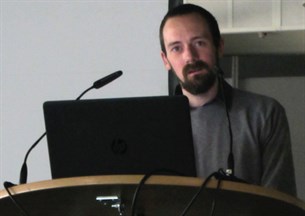All pest management events, wherever they are in the world, have one thing in common; they provide information and lots of it! The key points we gleaned from the seminar programme were: bed bugs and flat pack furniture are a challenging combination, sewer baiting in Germany is getting harder, but, at least, the Germans still try to control sewer rats and BASF have an interesting alternative rodenticide, if only the regulators would approve it!
Whilst the promoted theme for Pest-Protect was Food standards: All you can eat, the seminar programme ranged widely and your roving Pest reporters found themselves drawn to the non-food-related subjects namely, Alternatives to anticoagulant rodenticides, The end of traditional sewer baiting and News about bed bugs.
Seminar room packed for sewer debate
To begin with the sewers, the seminar room was packed – and it was a large room, seating 400+ people we heard. That tells us that there is still plenty of sewer baiting work taking place in Germany. This is in contrast to what we believe is happening in the UK. In the early days of our National UK Pest Management Survey, we asked a detailed question about where pest professionals did their pest control work. Very few spent any time sewer baiting. So, unless things have changed dramatically in the past four or five years, we can conclude it’s not a widespread activity here in the UK – unless, of course, you know any different. Do let us know.
In Germany there is a major regulatory change on the horizon which no doubt prompted the high attendance. Rodenticide baits will no longer be allowed to come into contact with water. The session, which took the form of a panel discussion, examined two possible alternative approaches – the mechanical WiseTrap from Anticimex, who completed the purchase of the trap’s developers, Wisecon, last April and the Ball-B device from German company Ball-B, which keeps the bait dry. Both devices use smart technology to send reports to Smartphones and the like.
 The expert panel discussed rodent control in sewers
The expert panel discussed rodent control in sewers
Alternative to anticoagulants draws the crowds
Also very popular was the session from Dr Thorsten Storck of BASF who outlined the company’s development work with some old chemistry, cholecalciferol.
BASF already has a rodenticide product based on cholecalciferol launched in Australia and the USA, but it is not yet approved in the EU. According to some industry pundits it may never be approved. If the research findings are correct though, we must hope those pundits are wrong because this old active presented in a new ‘yummy’ formulation looks to have a useful place in rodent control.
Cholecalciferol (vitamin D3) is produced naturally by all animals, including humans. To be effective as a rodenticide, the rodents need to eat a large enough dose to result in hypercalcaemia. However, because one of the first symptoms is loss of appetite, a successful bait needs to be very tasty to induce the rodents to eat a fatal dose over a short time period. The trials results presented showed how the new BASF formulation has achieved this.
|
|
|
Bed bugs to the fore
All the seminars were simultaneously translated from German into English which requires extra concentration, not to mention some guess work when the interpreter struggles to find the correct technical word! The bed bug session from the UK’s Dr Richard Naylor of the Bed Bug Foundation provided a welcome respite from the headphones.
Richard suggested that bed bugs should really be called bat bugs as there is evidence of Cimex lectularius feeding on bats for at least the plast 5,000 years.
He reminded his audience of the need for proper Integrated Pest Management (IPM) and that means understanding the way the bed bug and its human host behave and not just using two different control measures.
Amusingly he explained how his home had been infested with bed bugs twice. Richard breeds bed bugs for a variety of research and training purposes. The first infestation was deliberate as part of a research project and he only released a few male bed bugs, so there was no chance of a population explosion.
The second was in his children’s bedroom; the youngsters had inadvertently transported the bugs from the bed bug breeding arena to their bed room. That’s when he discovered that the bed, which came from a well known supplier of flat pack furniture, was pretty much impossible to treat because of all the cracks and crevices in the mechanisms used to hold the joints together! It had to be replaced.



 Dr Thorsten Storck from BASF talked about ‘yummy’ baits made from cholecalciferol
Dr Thorsten Storck from BASF talked about ‘yummy’ baits made from cholecalciferol